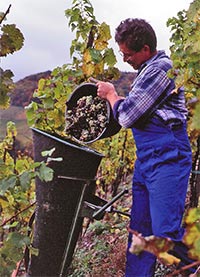
![]() 2000 Jahre Weinanbau an
2000 Jahre Weinanbau an
Mosel, Saar und Ruwer
With„ it was once ...“
if many stories begin, also with us in The Moselle, the Saar and Ruwer...
In 1787 the Trierer elector Clemens Wenzeslaus ordered that in our cultivation area only Riesling is to be cultivated.
This had results: thus we also are even today the biggest coherent Riesling cultivation area of the world.
Where wine wakes the life
The life on our rivers is stamped by a mild, well-balanced climate. In the Moselle valley it is much warmer, than by the surrounding heights Eifel and Hunsrück heights. Small wine villages narrowly cuddle up to the precipitous skew slopes and use the scanty space which remains to them between river run and Rebstöcken in the hollows. Wine tendrils and luxuriant oleander bushes which decorate the gabled houses and narrow lanes do the Moselle scenery the south in the north. Above the interlocking villages on the Moselle ridge medieval castles tower, often affectionately restored, from the vineyards. They are witnesses of our long tradition. Playful timber-framed buildings and ancient wine cellars provide on the Moselle, the Saar and Ruwer everywhere a feeling for the drinking joy not only in old time. The older Moselle houses are built often completely from slate, and most roofs are covered Gray-blue even today with his polishing - then what lies, in the end, closer, than to decorate the houses with him what counts since centuries to our biggest treasures?
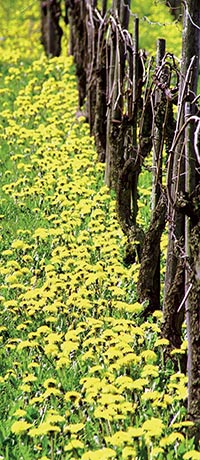
Three rivers and thousand stories
Every Fleck which offers an ideal climate to our grapes is used for the wine-growing. And whom it surprises there if to quite a lot of Rebhang, as a part of the life of our winegrowers, up to the Haustüre it reaches. Who planted, however, here as the first shoots and opened therefore our wine-growing area, is unsettled till this day. However, one is sure: The Romans already recognized about 2000 years ago the ideal possibilities of our slate part positions and founded a wine-growing culture unknown till then. Ausonius, prince's educator at the Roman emperor's court to Trier, already described 371 A.D. in his famous poetry„ Mosella“ the beauty of our scenery and of course our wine. Hymns of praise and drinking ballads have been written since that time many on the Moselle. And besides the advanced thinking just also pulled many scholars and philosophers in our region in the Middle Ages. Nikolaus Cusanus, co-founder of the modern philosophy, lived here in Bernkastel-Kues where still today his birthplace is to be visited. Revolutionary mind went out later from Karl Marx who was born in Trier, the oldest town of Germany. And of course Stefan Andre, Moselaner, Riesling fan and author who swarmed in numerous literary works over and over again about our wine region.
Wine culture experience
Tracks have them everything the Romans leave, especially of course. To the north of the Alps her buildings are to be found in such perfection only with us. Their reports impress almost everywhere: to all at the head of the Porta Nigra in Trier, as a landmark of our wine-growing region. Old winepress arrangements, as for example tell the wine ship to new stomach-Dhron or also about Roman wine culture in Piesport, earth or Maring-Noviand. Roman constructions interfere with baroque palaces. Medieval castles stand on Celtic foundation walls even today. Details surprise in every corner: Roadside calvaries in the vineyards, besides old poor leftovers which are maybe still from the Romans. However, not all culture is with us from yesterday: Today in numerous Moselle places cultural days and festival take place - as for example the Moselle festival. Besides many vineyards serve own cultural arrangements, as for example the row„ Youth makes music“.
Where climate and ground give her best
Our winegrowers follow with ambition and idealism her occupation. The Steillagen with her terraces and the often small plots which are managed since centuries in laborious manual labor demand not least it of them. A rule of thumb means, that the winegrower every single vine in„ Wingert“ 7 times per year must see. In the spring the shoots are bound, so e.g., in the traditional heart form. The care is costly and is read after long ripening period only in late autumn (the rare ice wine even only in frost). Since now the grapes have fortified her valuable contents materials. Our winegrowers know the advantages of the often impassable Steillagen - these are the most precipitous ones of the world! The climate is especially mild, the solar irradiation intensely. The dark, loose skew grounds store the solar warmth during day and deliver them at night to the shoots. The skew formations, from friable Grauwacken - up to soft sound slate, deliver the important mineral substances to the grape and stamp the later typical taste of the wines.
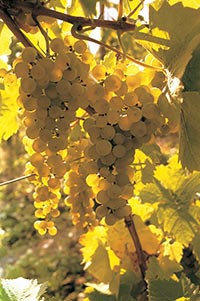
On the solar side
The Riesling shoot is the main kind of our cultivation area. She also becomes„ Queen of the shoots“ called and is the noblest white wine kind of Germany generally. And, otherwise, Riesling wines nowhere reach such a playful ease like with us on the Moselle, the Saar and Ruwer. The fame of our Riesling lies in his living-fresh kind, the fine aroma and his mineral taste components. This teamwork leads to his digestibility and the character rich in finesse. It guarantees the long durability and provides for the fact that with increasing maturity of top wines rarities become. The Müller-Thurgau, in his dry version with us often Rivaner called, distinguishes itself by an early maturity. As a real pint wine he should be drunk very freshly. Nevertheless, the oldest Rebsorte of our cultivation area is certainly the Elbling. The Romans brought him from Gaul with to the Moselle. Today the Elbling is grown almost exclusively on the upper Moselle. Since here on, mussel lime, he finds the best conditions for his uncomplicated freshness.
Land lives in the midst of wine and shoots
Whether now can discover along Roman Weinstrasse, with a castle tour or simply on the traces of our Riesling, with us everybody his. From the shore of the Moselle the Rebhänge look idyllic, the old vineyards and castles right in the middle romantic. However, already with a wandering by the Steillagen whose gradient strikes partly as alpine, visitors get a notion of the trouble which the wine-growing does here.
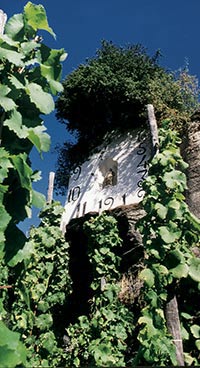
„ Monorack“ if the solution is called there for many winegrowers. Especially on the lower Moselle these rail roads, tool and person advance. Here, on cleft and hard Grauwackenschiefer, prosper especially flowery, elegant wines with a fine fruit acid. Wine lovers bump into open wine cellars everywhere in our approximately 130 wine places. In the Strauss's management and Gutsweinschänken our winegrowers offer to her own wines Moselländisches, from the potato court„ Scholes“ up to him„ Moselaal in Riesling sauce“. Even more wines, culinary and a lot of music gives’ see then of course at our wine parties, all at the head of the streets wine parties and wine courts parties. They take place just during the summer months to deeply at the night in the village streets or on the courts and in the cellars of our winegrowers....
Everywhere the Moselaner know to celebrate it, not only in the wine metropolises like Cochem, Bernkastel-Kues and Traben-Trarbach whose colored activity draws yearly thousands of visitors. Main season is the reading time - the autumn with us. Then it smells in the wine taverns enticing of fresh feather-white and onion pie. More tranquilly then the winter. Now interested in wine ones find the right leisure to try our wines directly with the winegrower. However, the new year is presented mostly only in early summer to the Verkostung - the Riesling needs, in the end, his long ripening period. Then here it also appears whether the efforts have been worthwhile. Whether now in quiet lanes or at lively parties: The Moselle, the Saar and Ruwer - an experience of land life, as it is only to be found rare.
Riesling dynasties and young talents
Fully of sound and mostly Celtic or Roman origin are the names of our slate part positions. Riesling wines of world-wide reputation are read here - and this already for ages. The long tap roots of the old Rebstöcke deeply penetrate into the slate and supply the shoots with the necessary minerals. In the Mittelmosel it is predominantly the Devon slate which determines the especially filigree, fine-fruity kind of these Riesling wines. Tradition also stamps the wine-growing in the small Ruwertal which lies covertly close to Trier. The wines from her top positions have a big call. On the light skew decomposition grounds there prosper tender Riesling wines with highly fine bouquet. The Saar Riesling shows a little bit other character. Wine connoisseurs call the wines of the Saar special speciality, because really the Saar Riesling impresses during big years by his elegance and race.
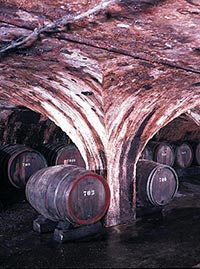
Solar clock and kingdom of heaven
In quite special years originate in tiny amounts of berry wine of selected grapess and dry wine of selected grapess. They belong to the best white wines of the world and bump into big international resonance, what to the famous one„ Aha experience“ on presentations and to top prices leads at auctions. Our vineyards steeped in tradition are often already known since the early Middle Ages, and only her splendid good buildings repay a visit. They maintain the art of the wine-growing in special litre of beer and more and more young winegrowers move up to them. Uncompromising quality is her common credo. Only what concerns the taste, there one competes with pleasure. High-class initiatives like German corner, the Moselle in 2000, the association Roman Weinstrasse, the Ruwer Riesling e. V. or also the friends of the Saar wine and friends of the Elblingweines to call only five devote themselves with a lot of enthusiasm and creative swing to our top product - to the wine.
Pints sting and bang cork
Wine is more than only one drink, it is also a living cultural asset. As an example our Elbling may count which the Romans already brought 2000 years ago to the Moselle and as a classic of the Obermosel today his Renaissance experiences.
More freshly Elbling
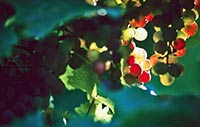 „
Uva Alba“ if they called the Romans - our Elblingrebe which finds ideal conditions
on the tiefgründigen mussel lime grounds of the Obermosel. The Moselle connects
to us here with our neighboring countries France and Luxembourg, and the
Elbling takes pleasure to international popularity. It is a fresh Zechwein
which our winegrowers develop strictly drily. In the Middle Ages, at the
times of the tenth courts, the Elbling was already in fashion. Today after
a long sleep he experiences his Renaissance. To owe he has primarily to his
engaged winegrowers who know how to market his qualities also successfully:
as a refreshing summer and pint wine which is also an excellent champagne
reason wine. Champagne of the Moselle, the Saar and Ruwer has become during
the last years a steady size. And this does not come by chance. Our fine-fruity
and sparkling Riesling and Elblingweine have all advantages to the champagne
production.
„
Uva Alba“ if they called the Romans - our Elblingrebe which finds ideal conditions
on the tiefgründigen mussel lime grounds of the Obermosel. The Moselle connects
to us here with our neighboring countries France and Luxembourg, and the
Elbling takes pleasure to international popularity. It is a fresh Zechwein
which our winegrowers develop strictly drily. In the Middle Ages, at the
times of the tenth courts, the Elbling was already in fashion. Today after
a long sleep he experiences his Renaissance. To owe he has primarily to his
engaged winegrowers who know how to market his qualities also successfully:
as a refreshing summer and pint wine which is also an excellent champagne
reason wine. Champagne of the Moselle, the Saar and Ruwer has become during
the last years a steady size. And this does not come by chance. Our fine-fruity
and sparkling Riesling and Elblingweine have all advantages to the champagne
production.
Since one is clear: A champagne is only so good, in the
end, always, as the wine of which he arises. With craft talent our winegrowers
create her champagne. The best of them are produced in the traditional bottles
fermenting procedure. The champagne remains, on this occasion, during the
whole Versektung in the one and same bottle and becomes for weeks from hand„
shaken“. With our winegrower's sects accents can be put, not least because
every bottle owns her own character and shows for itself a high-quality unique
specimen.
Whether to the champagne breakfast or to a ceremonious receipt,
the fine-fruity taste and the sparkling-fresh kind of our sect of the Moselle,
the Saar and Ruwer prepare unusual drinking Erlebnise.


